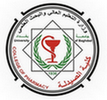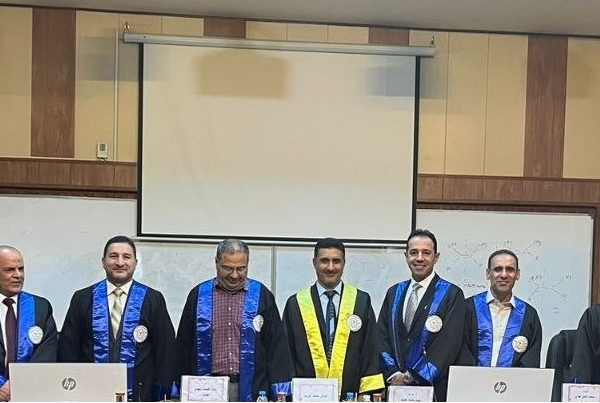The Faculty of Pharmacy discussed the PhD dissertation entitled “Design, Synthesis, Molecular Modeling Studies and Antitubulin Evaluation of Novel Heterocyclic Combretastatin A-4 Analogues” by Shaker Awad Abdul Hussein and his supervisor, Professor Dr. Ammar A. Kubba in the Pharmaceutical Chemistry Department. The study aimed to design and synthesize a new series of substituted benzoic acid derivatives (6-14, 24-26, 24a-b, 25a-d, and 26a-c) and to evaluate them in vitro for microtubule polymerization inhibition and cytotoxicity effects. Spectroscopic techniques were used to validate the target molecules, including FT-IR, 1HNMR, 13CNMR, and MS (ESI). Molecular docking studies were performed to determine the binding patterns to the potential molecular target (tubulin) and compared to an in vitro tubulin polymerization inhibition assay. The docking analysis for the titled compounds (6-14, 24-26, 24a-b, 25a-d, and 26a-c) revealed that the binding affinity values against the human tubulin target site, PDB ID: 4O2B, were as follows: ΔG = -12.97, -13.02, -14.0, -15.42, -15.14, -15.70, -15.86, -14.41, -14.92, -10.95, 11.75-,-13.55, -11.77, -11.88, -13.13, -13.10, -14.01, -12.51, -12.44, -12.73, and -12.57 kcal/mol, respectively, compared to the reference (colchicine), with an affinity value of -13.50 kcal/mol.Moreover, the in vitro cytotoxicity activity (in terms of IC50 values) of two groups of novel benzoic acid derivatives against three human cancer cell lines and one normal cell line study using a 3-(4,5-dimethylthiazol-2-yl)-2,5-diphenyl-2H-tetrazolium bromide (MTT) assay showed that all of the newly synthesized compounds were cytotoxic against the three different cancer cell lines. For the first group of compounds (6–14), compound (8) exhibited potent cytotoxicity activity against Hep G2 hepatocyte carcinoma, with an IC50 of 6.35 µM. Compound (8) induced the apoptotic pathway, arresting cells at the G2/M phase, as a result of targeting the mitotic spindle fiber. For the second group of compounds (24-26, 24a-b, 25a-d and 26a-c), compound (25b) was found to be comparable to colchicine in terms of cytotoxicity activity against the Hep G2 hepatocyte carcinoma cell line (3.38 and 2.51µM), respectively. Cell cycle analysis revealed that Hep G2 hepatocyte carcinoma cells treated with compound 25b were arrested in the G2/M phase. Compound (25b) inhibited microtubule polymerization at the IC50 concentration of 8.91 µM, which was comparable (X 1.7 times) to the IC50 of colchicine (5.13 µM) at the same cancer cell line. Our findings were supported by the molecular docking studies that showed compounds (8) and (25b) might be considered potential inhibitors for microtubule polymerization. The study concluded that the target compounds (8) and (25b) might be regarded as promising microtubular polymerization inhibitors that will be considered in the development of new anticancer agents.




